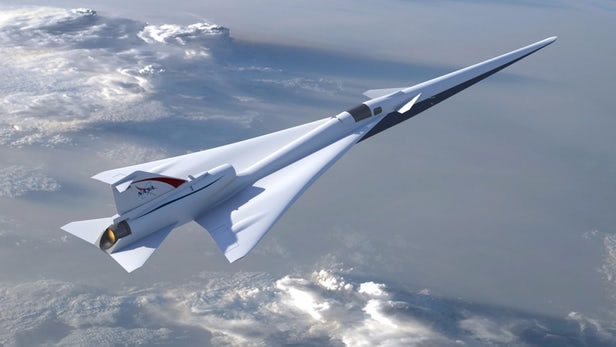
Tech & Sci
08:54, 16-Oct-2017
NASA Langley puts supersonic X-plane model to the test

A day trip to Moscow? Paris for lunch? NASA’s quest for low-boom supersonic aircraft technology could one day revolutionize commercial air travel.
Now NASA Langley Research Center in Hampton, Virginia is putting a sleek supersonic model plane through its paces in its 14-by-22 wind tunnel to move that vision closer to reality.
It’s called the QueSST aircraft design, for Quiet Supersonic Technology. And the idea is to convince Congress that super-fast commercial flights can be made overland – indeed, over communities – without generating that infamous sonic boom that can startle livestock, shatter windows and anger anyone within earshot. Supersonic flights over the US were banned in 1973 because of those booms.
“We’re trying to lift those regulations, and we need data,” said David Richwine, QueSST planning lead at Langley. “In order to get the data, you need an airplane that can do that.”
NASA came up with a preliminary design for its QueSST X-plane with partner Lockheed Martin, and various models have been undergoing wind tunnel tests.
Glenn Research Center in Cleveland, Ohio subjected a small 1.2-meter version to high wind speeds of Mach 1.5 and 1.6, or about 1,770 kph and 1,930 kph, to study aerodynamic performance and flight safety.
Now Langley is testing a larger model – 15 percent the size of an actual aircraft – at slower speeds to study its performance under different flap configurations and, especially, how it handles at lower speeds during take-off and landing. The 4.2-by-6.7 meter tunnel maxes out at 378 kph.
“Being a very fast airplane, it doesn’t like to fly slow,” Richwine said. “So understanding how to fly slow is very important.”

Samantha O’Flaherty, Test Engineer for Jacobs Technology, finalizes the set-up of the Quiet Supersonic Technology (QueSST) Preliminary Design Model inside the 4.2-by-6.7 meter Subsonic Tunnel at NASA Langley Research Center. /NASA Photo
Samantha O’Flaherty, Test Engineer for Jacobs Technology, finalizes the set-up of the Quiet Supersonic Technology (QueSST) Preliminary Design Model inside the 4.2-by-6.7 meter Subsonic Tunnel at NASA Langley Research Center. /NASA Photo
First, though, comes flying fast and quiet.
Sonic booms are created when shock waves generated by an aircraft flying faster than the speed of sound coalesce into what’s called an N-wave, which generates an explosive noise.
Richwine said he couldn’t “give away all the secret sauce” of their low-boom technologies but that it’s a combination of the craft’s long, slender shape, highly swept wings, and managing the control surfaces toward the back of the plane, all of which affect the way it generates lift.
“So this airplane, all the shocks underneath the airplane are weaker, so they don’t coalesce or come together,” Richwine said. “And, essentially, you get much more like a ‘thump’ sound.”
NASA has compared the sound to a sonic heartbeat.
Langley research aerospace engineer Courtney Winski has been assisting with the tunnel tests. If the industry adopts the low-boom technology, she said, it could change the entire concept of long-distance passenger flights.
“It’s neat to work on something that’s going to fly, or could fly,” Winski said. “A lot of things I’ve worked on previously have just been concepts early on, so working on something that flies is exciting.”
According to Lockheed, the QueSST X-plane is designed to fly at Mach 1.4 at an altitude of 16,764 meters.
Such speeds could cut long-distance flights in half – from New York to Los Angeles in a couple of hours, for instance, or New York to London in three.

Illustration of NASA’s planned Low Boom Flight Demonstration aircraft as outlined during the project’s Preliminary Design Review /NASA Photo
Illustration of NASA’s planned Low Boom Flight Demonstration aircraft as outlined during the project’s Preliminary Design Review /NASA Photo
Combining supersonics research and flight tests, Richwine said, is “kind of like a culmination of everything I’ve worked on in my career.”
“And if – maybe not me – but if I could make it so that my kids could actually fly on supersonic flights someday, I think it would change the world,” he added. “Much like the virtual world we have today – just being closer together. If you could fly and go visit your family in Europe in three hours, that would be a pretty big deal.”
NASA has already solicited bids from aircraft manufacturers to take its test data and come up with a final design and build, said Langley spokesman Robert Allen. It expects to choose an industry contractor early next year and have something to test in the air over Armstrong Flight Research Center in California by late 2021 or early 2022. Then comes a campaign of test flights over four to six selected communities to solicit real-world feedback.
“We’re trying to go out and test in communities and have a range of booms,” Richwine said. “We want to be much lower than ones that might be bothersome to the community so that we can prove what that range is – essentially identify a sonic boom number, a threshold that would be acceptable.”
NASA puts the cost of the entire five-year project at 390 million US dollars, if Congress funds it.
Seventy years ago next week, Richwine said, Chuck Yeager became the first pilot to break the sound barrier – and create the first sonic boom.
“It’s hard to figure that it’s been 70 years since we first flew supersonic, and we’ve had regulations against supersonic overland flight for 35 of those 70 years,” Richwine said.
“So really the motion of progress has been pretty slow over the decades. We’re hoping to change that.”
11368km
Source(s): AP

SITEMAP
Copyright © 2018 CGTN. Beijing ICP prepared NO.16065310-3
Copyright © 2018 CGTN. Beijing ICP prepared NO.16065310-3